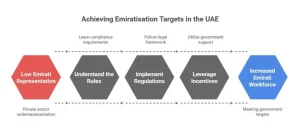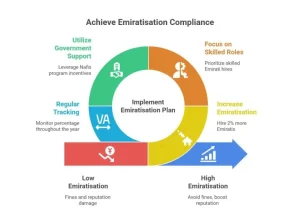Are you surviving in the UAE’s competitive market, or are you thriving? Whether or not you are hitting those emiratisation percentages can make all the difference. Balancing local talent with global expertise is what the country’s economy hinges on. And these emiratisation percentages are shaping workforces in the private sector.
A workforce shift is underway, and businesses can’t afford to wing it! UAE’s government has set clear targets to boost Emirati representation in the private sector. These targets aren’t just suggestions. They are a part of the legal framework companies need to follow if they want to stay compliant (and avoid those fines).
In this blog post, we will be discussing all the details about the current Emiratisation percentage, how it’s calculated, and what’s expected in 2025.
The required quota directly impacts licensing, penalties, and your ability to operate smoothly in the country. And in 2025, the numbers are shifting again. So if you are hiring in the UAE. Keep reading till the end to find out what the percentage actually is, the latest updates, and why ignoring it could get very expensive, very quickly.
Why is Emiratisation Percentage So Important?
That’s the important question. Why is the concept of emiratisation so stressful? And in this section, we will answer that. Because employers in the UAE are stressed about:
- Penalties for missing Emiratisation targets (up to AED 96,000 annually per missing employee).
- Confusion over calculating their Emiratisation percentage correctly.
- Uncertainty about how the 2025 deadline impacts long-term hiring strategies.
Now this can be easily fixed, but you have to be strategic about it. Start by trying to understand the rules. Implement them and leverage government incentives. And this way, you get to turn compliance into a competitive edge.
What is the Emiratisation Percentage?
It is the quota that defines how many Emirati nationals you, as a UAE-based company, need to hire compared to your total workforce. It’s part of the UAE’s national drive to increase Emirati participation in the private sector. And yes, it applies to you if your business is in the mainland and has 50 or more employees.
This measures the proportion of UAE nationals in your workforce relative to total employees. The government uses this metric to boost local employment, diversify the economy, and reduce reliance on expat talent. Think of it as a talent ratio:
- Private Sector: Currently at ~5% (2023), aiming to reach 10% Emiratisation in skilled roles by 2026
- Companies with 50+ employees are required to increase Emirati representation by 2% annually starting in 2023, aiming for 10% by 2026.
- Firms with 20 to 49 employees in select sectors must hire 1 Emirati by the end of 2024 and 2 by the end of 2025, or face fines of AED 96K (2024) and AED 108K (2025).
- Public Sector: Already exceeds 60%, setting a benchmark for others.
Emiratisation percentage is the minimum percentage of Emirati employees you must have in your workforce, as per UAE law. The target varies based on your sector, company size, and even your revenue in some cases.

Why Employers Should Care About the Emiratisation Percentage
Non-compliance costs money. And it costs a lot of it. That’s why by missing your required Emiratisation percentage in 2025, you are not only hurting your business reputation. You are inviting hefty fines that start from AED 96,000 per year (and that’s per missing Emirati hire!).
The longer you delay, the steeper the penalties get. This is a representation of it in numbers over the years:
- 2023 fines: AED 6,000 monthly per missing Emirati, rising by AED 1,000 per year through 2026.
- 2024/2025 penalties: AED 7,000 (2024) and AED 8,000 (2025) monthly per unfilled Emirati role, equating to AED 84,000 and AED 96,000 annually, respectively.
- From July 2025, fines increase to AED 9,000/month per missing position; compliance checks begin mid-year.
- Fake Emiratisation, i.e., falsifying records, might result in fines between AED 20,000 to 500,000 per violation.
Private Sector & Emiratisation Percentage
The initiative of Emiratisation is particularly aimed at the private sector. While expats and foreign nationals have previously dominated the numbers in these fields, the government is taking steps to make it equally inviting for UAE nationals as well. Right now, companies are expected to:
- Increase Emiratisation percentage by 2% per year.
- Focus specifically on skilled roles, not just headcount.
- Hit 6% by the end of 2024 and 8% by the end of 2025.
Government initiatives like Nafis support this push by offering salary subsidies, training programs, and recruitment incentives. All of these have been designed to help you meet or beat the quota without breaking the bank.
How You Can Calculate Emiratisation Percentage
MOHRE shares this formula to help you calculate emiratisation percentage in your business:
Emiratisation Percentage = (Number of Emiratis in Skilled Roles ÷ Total Skilled Workforce) x 100
If your company has 100 skilled employees and 4 of them are Emiratis, the percentage of Emiratis in your workforce is:
(4 ÷ 100) × 100 = 4%
The math is simple, but achieving those results might be a different story altogether. Especially if you don’t have a proper hiring plan in place.
Important notes:
- Only skilled roles count toward your quota
- Skilled roles = jobs that require education, experience, and specialized skills
- Non-skilled staff (for example: drivers, cleaners, etc.) are excluded from the equation
Don’t wait until year-end to check your percentage. Regular tracking keeps you ahead of compliance and the fines.

Key Emiratisation Percentage Updates for 2025
The rules keep updating, and 2025 brings some serious deadlines that you should know about:
1. Annual Increase Continues
- By June 2025, companies must increase their skilled workforce Emiratisation by another 2%.
- This brings the total to 6% for skilled roles (for companies with 50+ employees).
2. Mid-Year Checks
- Starting July 1, 2025, MOHRE conducts compliance audits, including verifying pension registration and WPS contributions for Emirati hires.
- A 1% mid-year target for skilled roles is required to be met by June 30. Otherwise, penalties will ensue.
3. New Sectors Under the Spotlight
- The government is zooming in on real estate, health, education, and IT. So expect sector-specific targets and closer compliance monitoring.
4. Penalties Are More Aggressive
- The fine for each missing Emirati hire goes up to AED 8,000 per month in 2025, and it compounds if left unpaid.
Why This Matters & Why You Should CareNow
Ignoring this now means you will be regretting it big time once the storm of consequences hits. Your business reputation is at stake. You will be missing out on incentives you could have leveraged. And you’d be losing that edge in government tenders. On the other side of this scenario, you have companies hitting or exceeding targets. And, as a result, they are:
- Accessing incentives like salary support through Nafis
- Building stronger relationships with local authorities
- Boosting employer brand appeal for top Emirati talent
What Happens If You Miss Your 2025 Emiratisation Target?
This is a quick preview of what non-compliance looks like:
- Hefty fines are charged per missing Emirati employee.
- Blocked visa quotas are making all future hiring harder.
- Red flags on government systems, affecting your company’s reputation and licensing.
- Risk of being excluded from government tenders.
Not exactly the growth strategy you had in mind, right?
Incentives You Can’t Ignore
The consequences of not achieving those numbers are serious. At the same time, the incentives for completing and exceeding those targets are shiny in their own right.
- NAFIS Grants: Up to AED 700,000 per company for hiring Emiratis.
- Salary Support: 30% to 80% subsidies for up to five years.
- Priority Tendering: Compliance boosts your chances in government contracts.
Private Sector Progress
The emiratisation percentage in the private sector has inched up from 2% in 2021 to ~5% today. That’s progress, definitely. Yet, it is not quite enough. The progress is gradual and steady, while there are some challenges too:
- Perception gaps: Some employers assume Emiratis prefer public sector roles.
- Skill mismatches: Rapid industry growth vs. localized training programs.
Though many companies are getting in touch with us, with their retention rates above 80% for UAE nationals, they prove it’s possible.
3 Ways to Turn Your Compliance into A Winning Strategy
Turn around your compliance factor into something compelling with these strategies:
Upskill Smartly
Partner with Emiratisation programs like Absher to train UAE nationals for niche roles.
Audit Annually
Track your metrics quarterly. Don’t wait for December panic.
Promote Inclusively
Highlight career growth paths to retain top local talent.
Quick Wins to Ace Your Emiratisation Percentage
If you want to get (and stay) ahead, here’s what actually works:
- Start recruiting early because last-minute hires often miss the mark.
- Tap into Nafis as salary subsidies can ease the payroll pressure.
- Offer real career paths.
- Work with a recruitment expert who knows the local talent market inside out.
- Train your HR team on compliance tracking and reporting.
Emiratisation Percentage in Private Sector: The Bigger Picture
The private sector historically lagged in Emiratisation compared to government entities.
That’s exactly why the UAE launched Nafis, the federal program incentivising private companies to hire and develop local talent. In fact, through Nafis, companies can get:
- Salary subsidies for hiring Emiratis (up to AED 8,000 per month per hire)
- Training support and career development programs
- Points towards future contracts and tenders
- Nafis’ incentives include 80% discounts on MOHRE fees. You get priority in procurement and a membership in the Emiratisation Partners Club for compliant employers.
So, when you think of the emiratisation percentage in the private sector, don’t just see compliance. See a strategic advantage that you can leverage.
Common Myths About Emiratisation Percentage
Let’s clear up some misunderstandings before they cost you:
❌ “I only need to hire one Emirati and I’m done.”
- Nope. It’s a percentage, not a headcount.
❌ “I can hire Emiratis in any role.”
- Wrong again. Only skilled roles count towards your percentage.
❌ “I’ll handle it next year.”
- Procrastination gets expensive fast. Fines apply quarterly in many cases.
The Real Reason Most Companies Struggle with Emiratisation
Finding the right Emirati talent for skilled roles isn’t as simple as posting a job ad. It requires:
- Understanding where to source qualified candidates.
- Creating competitive offers because every company is chasing the same talent pool.
- Offering real career growth
This is exactly why outsourced Emiratisation solutions exist: to match companies with the right candidates faster, while keeping 100% compliant with MoHRE requirements.
Nail Your Emiratisation Percentage
Are you calculating the percentage for the first time for your business? Or are you currently scrambling to close the gap? If you are behind on targets or planning for 2025, Emiratisation Nafis can make the process easier and smarter. From strategic workforce planning to sourcing qualified Emirati talent, our team makes it easy to hit your numbers. Let’s get you compliant and competitive. Talk to our Emiratisation experts today.
The 2025 deadline isn’t waiting. And neither should you. Let’s turn those mandates into some serious momentum. We have the tools and resources to help. So book a consultation today.
Final Takeaway
Hitting emiratisation targets does save you from fines that are too costly, both monetary and reputation-wise. But you also win by future-proofing your business. You have Emiratis bring their localized insights, Arabic fluency, and cultural fluency to your workforce. Working with those national goals also earns you some serious goodwill. So it is a win-win situation all around.
Emiratisation percentage is the new reality for every private sector company in the UAE with 50+ employees. At the same time, firms in certain sectors having 20 to 49 workers also must hire at least 2 Emiratis by the end of 2025. Or they are risking a 108k AED fine by the end of this year! Last year, they were required to hire at least one Emirati by the end of the year. Not doing so had them fined 96k AED! With targets rising every year, staying ahead means starting now and doing it right.
We wrote this guide to help you calculate your current percentage, plan for 2025, and have a better insight into the rules. And if you want experts’ assistance with meeting those targets, we are only a call away! Get in touch with our team now.
FAQs for Emiratisation percentage
Q1: What is the Emiratisation percentage?
The percentage is the mandatory quota of Emirati national companies that must hire in skilled roles. This ensures stronger local workforce participation and compliance.
Q2: How is the Emiratisation percentage calculated in UAE businesses?
The percentage is calculated by dividing the number of Emiratis in skilled roles by the total skilled workforce. Then, multiply by 100 to get the ratio.
Q3: What are the current targets for Emiratisation in private sector companies?
Private companies with 50 or more workers must increase Emiratisation by 2 percent annually. By 26, it reaches 10 percent. Organizations having a staff of 20 to 49 must hire two Emiratis by 2025.
Q4: What fines do businesses face for missing targets?
Missing targets may result in huge fines. It starts at 7,000 Dirhams per month per missing Emirati in 2024. This rose to 8,000 Dirhams monthly in 2025.
Q5: Which company size categories have different Emiratisation requirements?
Organizations with 50 or more workers must hit annual 2 percent increases in skilled roles. Companies with 20 to 49 staff must employ one Emirati by 2024 and two by 2025.
Q6: What is the formula to calculate Emiratisation percentages?
You can use MOHRE’s formula to calculate Emiratisation %: Number of Emiratis ÷ Total Skilled Workforce × Hundred.
Q7: How can employers monitor their Emiratisation percentage?
To secure qualified talent before deadlines, employers:
- Track the ratio quarterly
- Use Nafis for subsidies
- Start recruitment early
- Upskill Emiratis



